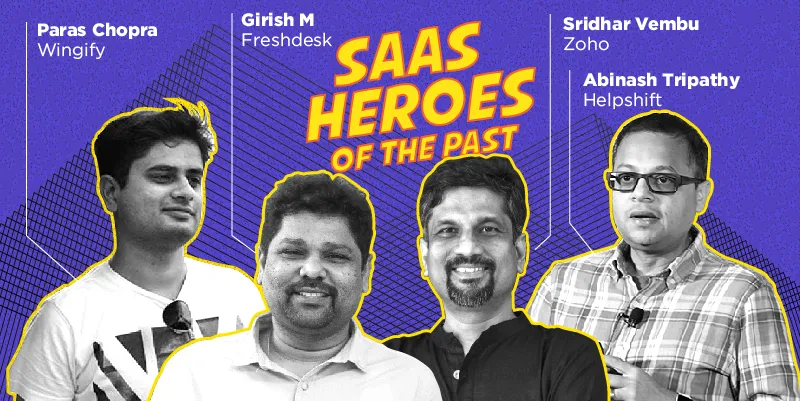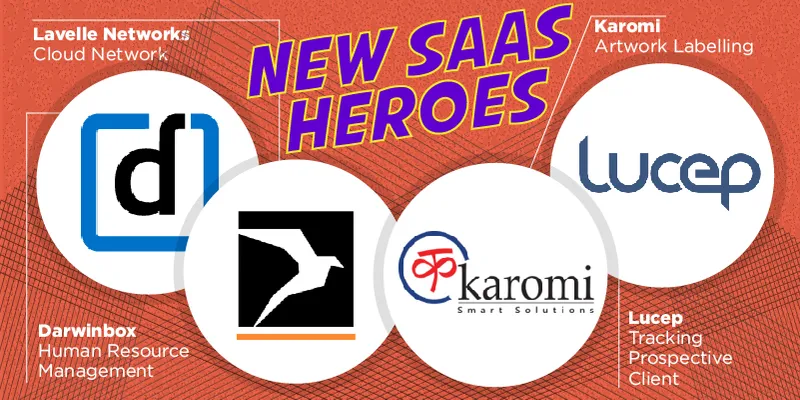Freshdesk and Zoho springboard the rise of the new SaaS brigade
According to Signal Hill and iSpirit, the Indian SaaS business is evolving from a horizontal to a vertical approach, thus increasing the lifetime value of the business.
About two years ago, two IIT-IIM alumni and an XLRI alumnus got together after a four-year stint in the corporate world to make a dent in the human resource software product universe.
While Jayant Paleti, Rohit Chennamaneni, and Chaitanya Peddi were working in consulting companies like McKinsey and EY, they realised that the businesses they were advising did not have proper human resource (HR) functions neither did they view it as a strategic function. But they had no idea that they would soon become a sought-after software-as-a-service (SaaS) company. It all started with some good word in the market.
Last year, when logistics company Delhivery went shopping for an end-to-end HR solution they had a very difficult time. They spoke to numerous corporate groups for a fix pertaining not only to data capture, but which would also be mobile-first and employee-centric.
They asked for integrated tools like self-evaluation, which the large companies did not deliver at the desired cost, and which were not readily deployable. But then Delhivery came across Darwinbox. The founders were able to quickly understand Delhivery’s needs, and in six months of meeting, closed a deal to deploy HR solutions for 16,000 of its employees.
This deal opened the market for Darwinbox, which has more than 50 clients covering more than 1.20 lakh employees. The company works on a per employee basis and is scaling up fast. Darwinbox is a solution that combines all disparate HR solutions into one box, from payroll to human capital management, and is delivered over the cloud. Says Jayant of Darwinbox,
“One only has to spend time in organisations and you will find several HR systems that do not talk to each other. They do not make sense for making the employee productive.”
The company has gone on to raise an undisclosed round of venture capital money from 3one4 Capital and three other investors.
There are other entrepreneurs doing seemingly crazy things as well. Meet Hemanth SM, Co-founder of Bezirk. He and his teammates split their time between the US and India trying to win the hearts of retailers.
Their software, which sits in stores, is able to track the shopping behaviour of consumers at every aisle, and will dynamically place ads on the smartphone based on their interest.
On one level, brands get to push store-level brand promotion dynamically with the retailer. “The software understands each individual uniquely and is unobtrusive. The millennial generation has no problem in sharing data and using data that is useful,” says Hemanth.
Bezirk is now going all out in the US, with a mandate to cover 2,000 stores for a retailer. In India, it is piloting a couple of retail organisations which it did not want to disclose.

The beginning
Software-as-a-service is undergoing sea change as an industry. It has moved from dynamic ticket generation and addressing of queries to advanced analytics based on behaviour of consumers and businesses to increase revenues. But it all started somewhere.
One can only thank Freshdesk’s Girish Mathrubootham for showing the way to Indian entrepreneurs that they can create a strong SaaS business based out of India. Girish is the original SaaS hero along with his long-time friend and mentor Sridhar Vembu of Zoho.
In 2011, when Freshdesk’s smart pricing and technology helped businesses address queries dynamically it created a wave of me-too companies. In the process the company encouraged so many individuals to set up their own SaaS shop.
“Entrepreneurs should realise that throwing money at a problem is not the best way to solve things,” Girish had said in an earlier interview with YourStory.
While it has been a rough patch for a few, there are some who have come out with innovative business models and technology services to thrive across the world. It is fair to say that these companies are our next wave of SaaS startups that can change the way Indian businesses and government use technology to deliver services over the cloud.
According to a report jointly commissioned by Signal Hill and iSpirit, a think tank, it takes a median of anywhere between two to four years to generate an annual run rate of Rs 6.7 crore. The report goes on to add that the young SaaS ecosystem has an Accounting Rate of Return (ARR) of $.75 million compared to the $5 million of the US ecosystem.
The good part is the current set of startups are focused on verticals rather than horizontals. Abinash Tripathy, Founder of Helpshift, believes that this will increase the lifetime value of the SaaS business.
“The difference between the old-world packaged software (on-prem) versus SaaS is like the difference between buying a house versus renting one,” says Abinash, whose company Helpshift helps companies address tickets real time raised in their app. He adds that the goal of a SaaS business is all about charging for Opex (as opposed to Capex) for the long term.
The economics start to work when customers continue using the software for a long time and it covers the lifetime value cost of acquiring plus cost of hosting and support.
Most SaaS businesses do not make a profit on a customer for some period of time as they have to recover the cost of acquisition. After a period of four years, if the customer does not churn and continues to pay for the service, then the business starts to generate profits for that customer.
“Typically, the SMB-focussed SaaS companies from India provide a shallow product that is not sticky, and the customer outgrows the product and needs a more enterprise-ready one,” says Abinash. These companies also rely heavily on paid marketing and deep discounting—like the Indian e-commerce industry—to grow quickly, only to be stuck with high monthly churn, which breaks the economics and makes the model unsustainable.
The rules for building a large, profitable SaaS business are:
- Having a wide market.
- With high ASPs (Average Selling Price).
- Where CAC (Cost of Acquiring Customers) is relatively low.
- Churn is low (product is a core part of the workflow and sticky)
- Opex is low (your hosting/AWS bill is lower than the revenue you earn every month with a margin of less than 60 percent).
According to a report by Accel Partners and Google, SaaS will contribute to more than 75 percent of the public cloud revenues, driving the global SaaS industry to $132 billion revenue by 2020. The SaaS products will see adoption by SMBs, which are expected to reach $76 billion.

The new SaaS heroes
We spoke about Bezirk and Darwinbox, both sub-$1 million companies. Like them, there are more companies that have the potential to go global.
Satyam Darmora’s i2e1 (information to everyone) makes Wi-Fi available to everyone and allows retailers to drive footfalls in their stores. The hardware investments are made by the businesses, which i2e1 preps to communicate with shoppers.
The company frees up bandwidth that is not used by the retailer to the consumer and then it identifies the consumer, after he or she logs in, to show relevant marketing collateral.
Shifting away from the retail business and focusing on the consumer goods industry is Karomi, a Chennai-based tech business, which allows FMCG companies to track their labelling art. The company has crossed Rs 2 crore in revenues and is looking at the US market to expand its operations.
Perhaps the most interesting SaaS startup is Lavelle Networks, which uses the cloud to connect all offices regardless of the Internet package they are on. Say, if Office A is using Reliance Jio and Office B is using Airtel. Sometimes the communication between the two sites may be blurry and loose. So Lavelle creates points of presence in Office A and Office B, where the software brings both sites to a data centre running on zero-latency networks.
The experience is unique for the corporate as their video and voice applications never fail. The company today has a turnover of Rs 2 crore and is going to expand in India and the US.
Then there are companies like Lucep, which allow businesses to call their prospective customers once the customer leaves the numbers on the website instead of waiting for the data to be lying idle in the CRM. Its founder, Kaiesh Vohra, says that converting an indecisive customer to a satisfied customer only happens with data being made available to the sales manager.
There are several other SaaS heroes like Racetrack.in, which focuses on machine learning to connect customers to the institutions (realty in this case) that they engage with. Their bot, Marvin, is able to make sense of not just requests of house and apartment type, but also answer questions on amenities in the community, education, and healthcare facilities.
Then, there is Lobb, which connect truckers, agents, and transport companies across the country. The Lobb platform makes sure that a transport company and the agent use the driver both ways (which did not happen earlier) and it has been able to bring down the price for prospective clients of transport companies.

“Today, most companies want to add as many customers as possible. There is more focus on the sale, and they are yet to increase the lifetime value of the customer,” says Yanna Dharmasthira, Research Director at Gartner Inc, adding that SaaS is a model widely being advocated across several product companies like Microsoft and SAP, too.
But the primary difference between these billion-dollar companies and the smaller SaaS companies is that the founders drive the sales in case of the latter, and they have direct relationships with the business heads of organisations.
Large product companies work with vendors—like Infosys and Wipro—and sales channels for the product to be implemented. This should help these startups establish a direct connection with brands to cross-sell services.
“There is a price war going on for customer acquisition. So you are really not making money on your service, and the marketing costs are high,” says Yanna of Gartner, adding that in that context the smaller companies are going to suffer because capital is being burned. “But SaaS is here to stay and enterprises see the benefits of the cloud,” she adds.
“I must advise startups that you need partners or investors who will stay invested with you for life and help build great technology,” says Vembu of Zoho Corp.
Nevertheless, there are several Indian SaaS companies that will become the future of global business and these startups are just a few names to watch out for.







